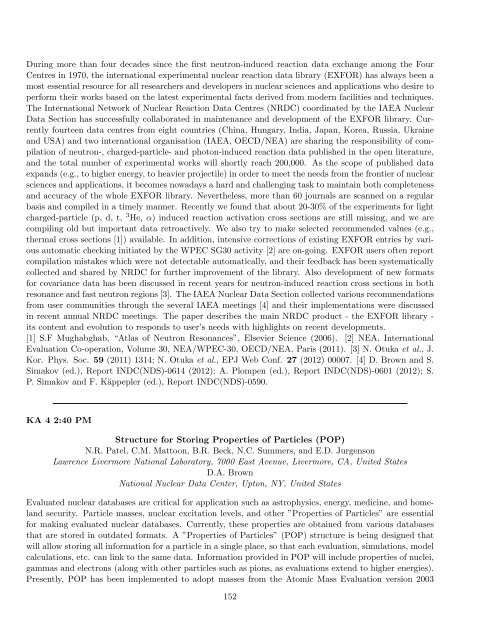Program - Brookhaven National Laboratory
Program - Brookhaven National Laboratory
Program - Brookhaven National Laboratory
You also want an ePaper? Increase the reach of your titles
YUMPU automatically turns print PDFs into web optimized ePapers that Google loves.
During more than four decades since the first neutron-induced reaction data exchange among the Four<br />
Centres in 1970, the international experimental nuclear reaction data library (EXFOR) has always been a<br />
most essential resource for all researchers and developers in nuclear sciences and applications who desire to<br />
perform their works based on the latest experimental facts derived from modern facilities and techniques.<br />
The International Network of Nuclear Reaction Data Centres (NRDC) coordinated by the IAEA Nuclear<br />
Data Section has successfully collaborated in maintenance and development of the EXFOR library. Currently<br />
fourteen data centres from eight countries (China, Hungary, India, Japan, Korea, Russia, Ukraine<br />
and USA) and two international organisation (IAEA, OECD/NEA) are sharing the responsibility of compilation<br />
of neutron-, charged-particle- and photon-induced reaction data published in the open literature,<br />
and the total number of experimental works will shortly reach 200,000. As the scope of published data<br />
expands (e.g., to higher energy, to heavier projectile) in order to meet the needs from the frontier of nuclear<br />
sciences and applications, it becomes nowadays a hard and challenging task to maintain both completeness<br />
and accuracy of the whole EXFOR library. Nevertheless, more than 60 journals are scanned on a regular<br />
basis and compiled in a timely manner. Recently we found that about 20-30% of the experiments for light<br />
charged-particle (p, d, t, 3 He, α) induced reaction activation cross sections are still missing, and we are<br />
compiling old but important data retroactively. We also try to make selected recommended values (e.g.,<br />
thermal cross sections [1]) available. In addition, intensive corrections of existing EXFOR entries by various<br />
automatic checking initiated by the WPEC SG30 activity [2] are on-going. EXFOR users often report<br />
compilation mistakes which were not detectable automatically, and their feedback has been systematically<br />
collected and shared by NRDC for further improvement of the library. Also development of new formats<br />
for covariance data has been discussed in recent years for neutron-induced reaction cross sections in both<br />
resonance and fast neutron regions [3]. The IAEA Nuclear Data Section collected various recommendations<br />
from user communities through the several IAEA meetings [4] and their implementations were discussed<br />
in recent annual NRDC meetings. The paper describes the main NRDC product - the EXFOR library -<br />
its content and evolution to responds to user’s needs with highlights on recent developments.<br />
[1] S.F Mughabghab, “Atlas of Neutron Resonances”, Elsevier Science (2006). [2] NEA, International<br />
Evaluation Co-operation, Volume 30, NEA/WPEC-30, OECD/NEA, Paris (2011). [3] N. Otuka et al., J.<br />
Kor. Phys. Soc. 59 (2011) 1314; N. Otuka et al., EPJ Web Conf. 27 (2012) 00007. [4] D. Brown and S.<br />
Simakov (ed.), Report INDC(NDS)-0614 (2012); A. Plompen (ed.), Report INDC(NDS)-0601 (2012); S.<br />
P. Simakov and F. Käppepler (ed.), Report INDC(NDS)-0590.<br />
KA 4 2:40 PM<br />
Structure for Storing Properties of Particles (POP)<br />
N.R. Patel, C.M. Mattoon, B.R. Beck, N.C. Summers, and E.D. Jurgenson<br />
Lawrence Livermore <strong>National</strong> <strong>Laboratory</strong>, 7000 East Avenue, Livermore, CA, United States<br />
D.A. Brown<br />
<strong>National</strong> Nuclear Data Center, Upton, NY, United States<br />
Evaluated nuclear databases are critical for application such as astrophysics, energy, medicine, and homeland<br />
security. Particle masses, nuclear excitation levels, and other ”Properties of Particles” are essential<br />
for making evaluated nuclear databases. Currently, these properties are obtained from various databases<br />
that are stored in outdated formats. A ”Properties of Particles” (POP) structure is being designed that<br />
will allow storing all information for a particle in a single place, so that each evaluation, simulations, model<br />
calculations, etc. can link to the same data. Information provided in POP will include properties of nuclei,<br />
gammas and electrons (along with other particles such as pions, as evaluations extend to higher energies).<br />
Presently, POP has been implemented to adopt masses from the Atomic Mass Evaluation version 2003<br />
152
















